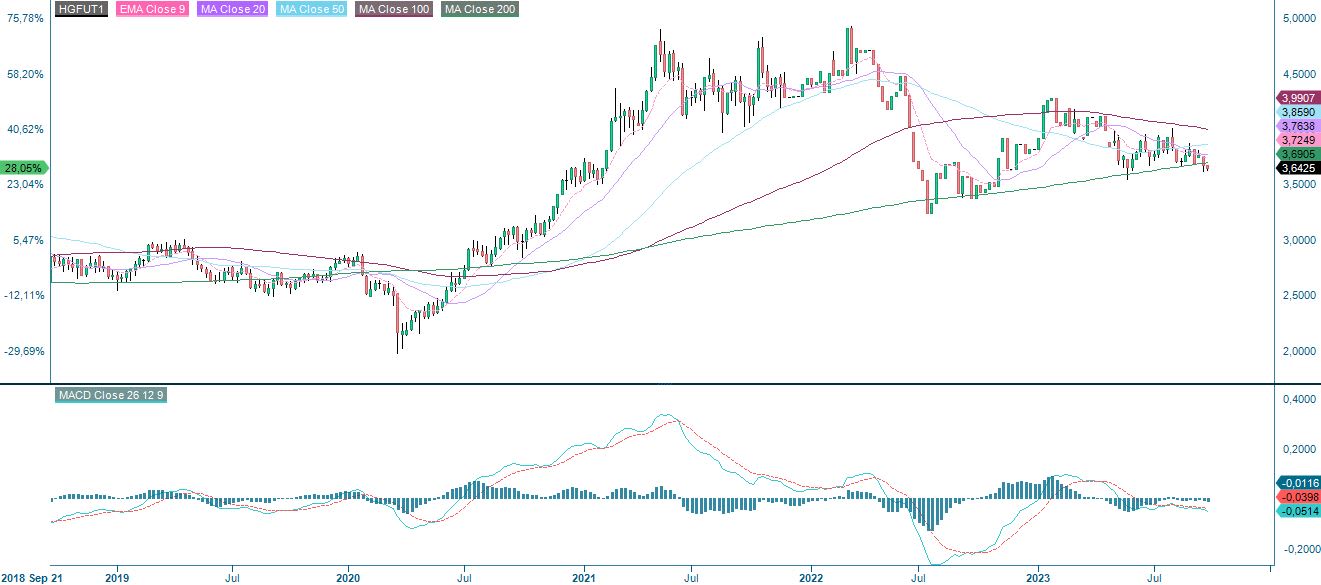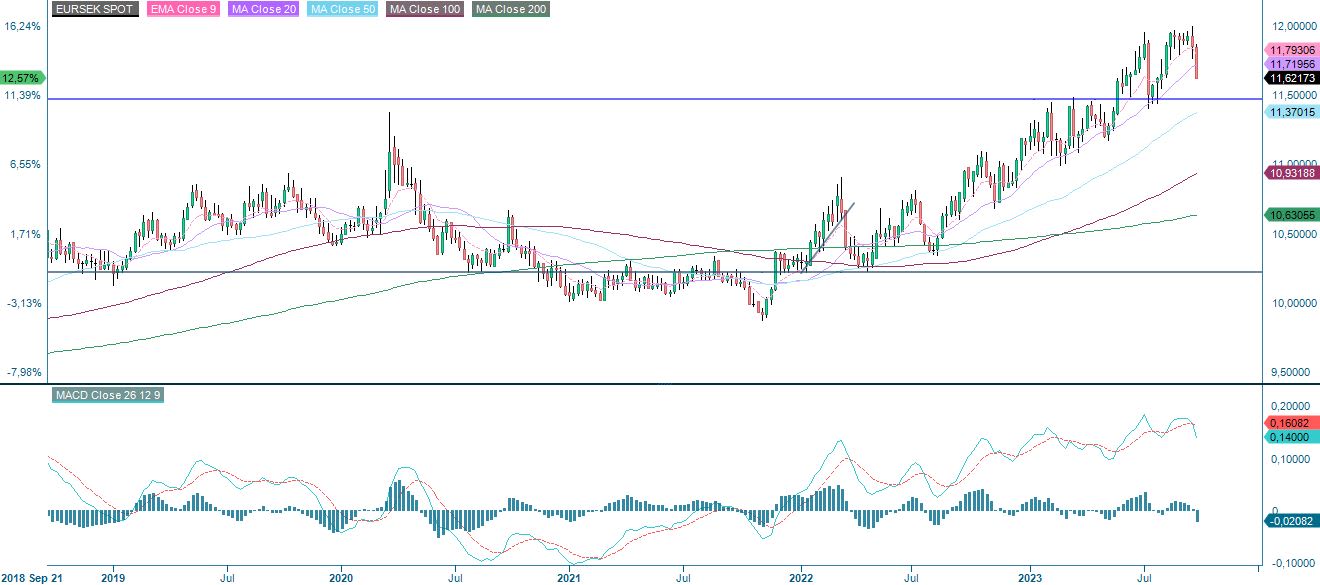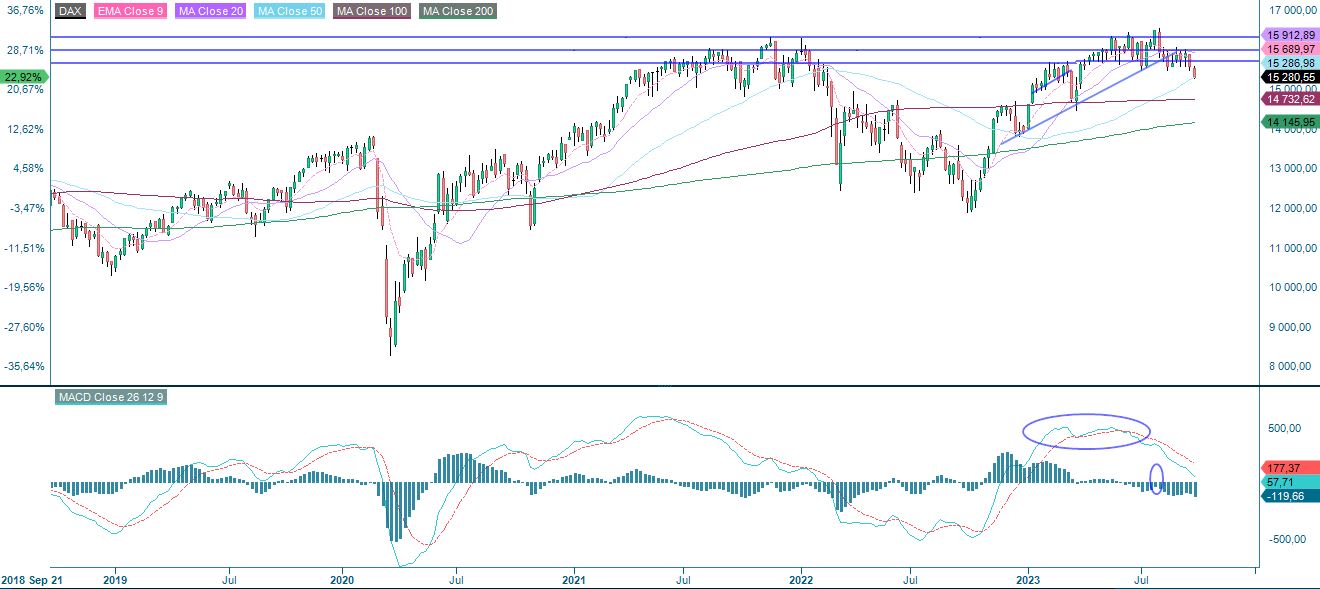Weak copper sentiment offset by indices at support levels

Copper prices rose in early 2023 on hopes of a recovery in the Chinese economy but have since fallen back. Analysts expect a surplus in the copper concentrate market in 2023 and 2024. US Treasury yields continued to rise following the Fed's rate announcement on 20 September. Technically, several major equity indices are now trading at support levels.
Case of the week: Copper at risk of dropping as headwinds mount
“Dr Copper” is considered an essential indicator of economic activity because of the metal’s widespread application in everything from home building to electronics. It rallied at the beginning of the year partly on hopes relating to the re-opening of the Chinese economy. However, the price has fallen and turned year-to-date (measured in USD).
Copper (in USD) vs. Chinese stocks (in CNY), one-year daily chart

The economic backdrop is somewhat murky. On the positive side, US growth has held up better than expected in 2023, increasing hopes of a soft landing. However, purchasing managers' indices are generally in contractionary territory. In China, the real estate sector is under pressure. In general, slower residential investment due to higher interest rates is a significant concern for the price of copper. On the other hand, the intense production of electronic vehicles has contributed to robust copper demand in China in 2023. Chinese car companies have, at the same time, come under anti-subsidy scrutiny in Europe recently. If the trade conflict escalates, sentiment in metal markets might be negatively affected. According to S&P Capital IQ, LME and COMEX copper stocks are rising, and its analysts expect a surplus in the copper concentrate market in 2023 and 2024. The US dollar hovering close to highs for this year is also a headwind.
From a technical perspective, the price of copper has fallen into a negative trend below the MA 200 in the daily chart. It appears to be in a consolidation pattern following the large price swings in 2022. A breakout in either direction might trigger a major price moment. For the moment, the bears seem to have the upper hand. However, copper is approaching oversold territory.
Copper (USD/LB), one-year daily chart

Copper (USD/LB), five-year weekly chart

Macro comments
As expected, the Fed left interest rates unchanged on Wednesday evening, 20 September. However, the market interpreted the outlook as hawkish. At the press conference, Powell clarified that the Fed is prepared to raise rates again if necessary. In the bond market, interest rates rose, with the 10-year US Treasury rising 10 points to 4.43% and the 2-year US Treasury rising 13 points to 5.18%. The USD gained around 1% against the Euro overnight. These US Treasury rates have changed to 5.10% and 4.53% in writing, respectively. The spread between 2-year and 10-year US Treasury yields has narrowed from 110 bps (basis points = 1.10%) this summer to just 60 bps (0.60%).
The US economy is the strongest among the Western industrialised nations. The US labour market has cooled somewhat but remains strong. The central bank has raised its GDP forecasts for 2023 and 2024 and lowered its unemployment forecast from 2023 to 2025. The federal funds rate is expected to remain higher longer than the bank's June forecast.
US 10-year Treasury Yield (in %), one-year daily chart

US 10-year Treasury Yield (in %), weekly five-year chart

As expected, the Riksbank raised Sweden's key interest rate by 25 basis points to 4.0%. One of the motives is to strengthen the Swedish krona. The Swiss central bank left its key interest rate unchanged at 1.75%. This significantly lower level of interest rates has been sufficient to keep the Swiss franc well above the SEK and the Euro. Our take is that today's higher interest rate level will last longer than the market previously thought for 2024. However, the EUR/SEK has weakened from around 11.90 to 11.63 at the time of writing.
EUR/SEK, weekly five-year chart

The weighted purchasing managers' index (PMI) for the eurozone rose marginally to 47.1 in September, slightly above market expectations of 46.5. The business climate, particularly in the euro area, is weakening at the end of Q3 2023 (PMI < 50). New orders are falling, pointing to a future decline in production.
On Friday, the 29th of September, the Eurozone's CPI for September is due. It is expected to have fallen to an annualised rate of 4.8% from 5.3% in the previous month. On Friday, the US will release its PCE inflation for August, expected to have fallen to an annualised rate of 3.9% compared to 4.2% in July.
Several indices have reached support levels
S&P 500 has broken the neutral wedge formation on the downside and MA100. The index is currently trading at support of around 4,330. Momentum is negative and falling. In case of a break on the downside, the index may be headed towards MA200, just above 4,200. In case of a bounce back up, MA100 is the first resistance level, currently trading around 4,390.
S&P 500 (in USD), one-year daily chart

S&P 500 (in USD), weekly five-year chart

The Nasdaq 100 is trading just below MA100 but at support around 14,650. The next level on the downside is found around 14,300.
Nasdaq 100 (in USD), one-year daily chart

Nasdaq 100 (in USD), weekly five-year chart

Rates are currently ticking upward, which typically is bad news for stocks. However, from a technical perspective, the rates need a break, thus creating opportunities for realising some profits from short positions. Going long may also be interesting for the risk-seeking, but keep stop losses tight. Also, note that momentum has turned to falling in the weekly charts for both S&P 500 and Nasdaq 100.
In Sweden, OMXS is currently trading at support just above 2,130. In case of a break on the downside, the next level is around 2,050.
OMXS30 (in SEK), one-year daily chart

OMXS30 (in SEK), weekly five-year chart

After some time, DAX has finally broken out of a narrow trading range. Like the other indices,
DAX is trading at support around 15,150. The next level on the downside can be found just above 14,900.
DAX (in EUR), one-year daily chart

DAX (in EUR), weekly five-year chart

The full name for abbreviations used in the previous text:
EMA 9: 9-day exponential moving average
Fibonacci: There are several Fibonacci lines used in technical analysis. Fibonacci numbers are a sequence in which each successive number is the sum of the two previous numbers.
MA20: 20-day moving average
MA50: 50-day moving average
MA100: 100-day moving average
MA200: 200-day moving average
MACD: Moving average convergence divergence
Risks
External author:
This information is in the sole responsibility of the guest author and does not necessarily represent the opinion of Bank Vontobel Europe AG or any other company of the Vontobel Group. The further development of the index or a company as well as its share price depends on a large number of company-, group- and sector-specific as well as economic factors. When forming his investment decision, each investor must take into account the risk of price losses. Please note that investing in these products will not generate ongoing income.
The products are not capital protected, in the worst case a total loss of the invested capital is possible. In the event of insolvency of the issuer and the guarantor, the investor bears the risk of a total loss of his investment. In any case, investors should note that past performance and / or analysts' opinions are no adequate indicator of future performance. The performance of the underlyings depends on a variety of economic, entrepreneurial and political factors that should be taken into account in the formation of a market expectation.
Disclaimer:
This information is neither an investment advice nor an investment or investment strategy recommendation, but advertisement. The complete information on the trading products (securities) mentioned herein, in particular the structure and risks associated with an investment, are described in the base prospectus, together with any supplements, as well as the final terms. The base prospectus and final terms constitute the solely binding sales documents for the securities and are available under the product links. It is recommended that potential investors read these documents before making any investment decision. The documents and the key information document are published on the website of the issuer, Vontobel Financial Products GmbH, Bockenheimer Landstrasse 24, 60323 Frankfurt am Main, Germany, on prospectus.vontobel.com and are available from the issuer free of charge. The approval of the prospectus should not be understood as an endorsement of the securities. The securities are products that are not simple and may be difficult to understand. This information includes or relates to figures of past performance. Past performance is not a reliable indicator of future performance.
© Bank Vontobel Europe AG and/or its affiliates. All rights reserved.
